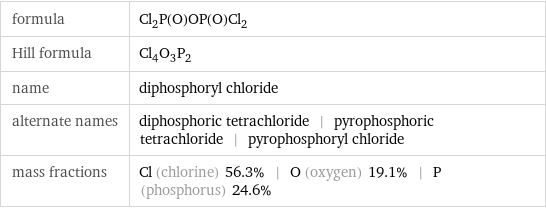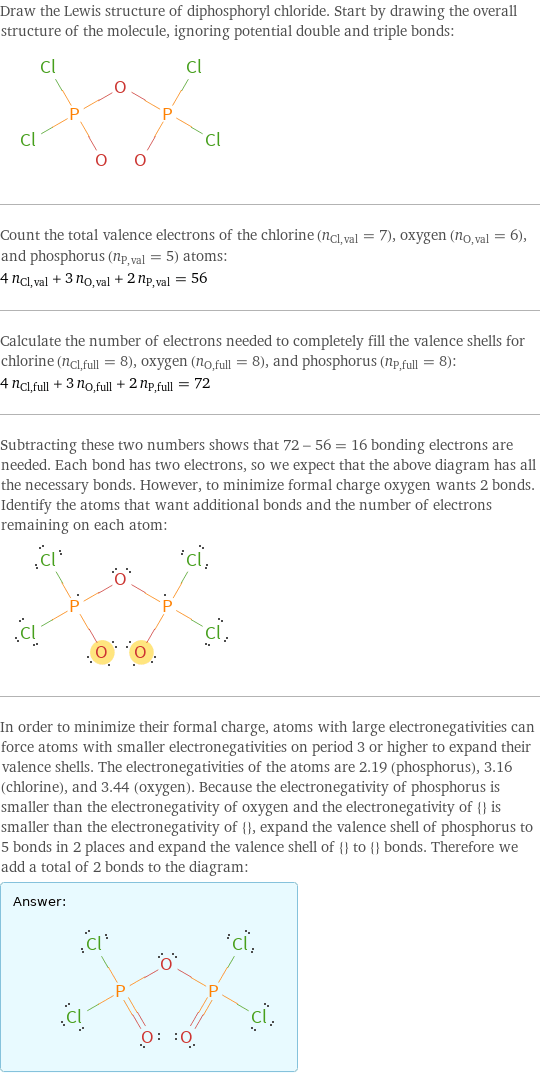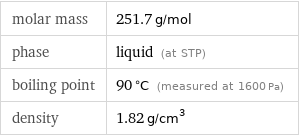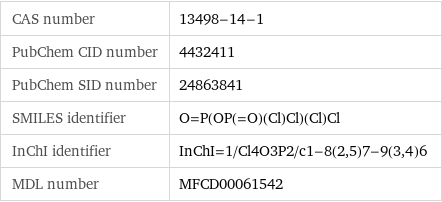Input interpretation

diphosphoryl chloride
Chemical names and formulas

formula | Cl_2P(O)OP(O)Cl_2 Hill formula | Cl_4O_3P_2 name | diphosphoryl chloride alternate names | diphosphoric tetrachloride | pyrophosphoric tetrachloride | pyrophosphoryl chloride mass fractions | Cl (chlorine) 56.3% | O (oxygen) 19.1% | P (phosphorus) 24.6%
Lewis structure

Draw the Lewis structure of diphosphoryl chloride. Start by drawing the overall structure of the molecule, ignoring potential double and triple bonds: Count the total valence electrons of the chlorine (n_Cl, val = 7), oxygen (n_O, val = 6), and phosphorus (n_P, val = 5) atoms: 4 n_Cl, val + 3 n_O, val + 2 n_P, val = 56 Calculate the number of electrons needed to completely fill the valence shells for chlorine (n_Cl, full = 8), oxygen (n_O, full = 8), and phosphorus (n_P, full = 8): 4 n_Cl, full + 3 n_O, full + 2 n_P, full = 72 Subtracting these two numbers shows that 72 - 56 = 16 bonding electrons are needed. Each bond has two electrons, so we expect that the above diagram has all the necessary bonds. However, to minimize formal charge oxygen wants 2 bonds. Identify the atoms that want additional bonds and the number of electrons remaining on each atom: In order to minimize their formal charge, atoms with large electronegativities can force atoms with smaller electronegativities on period 3 or higher to expand their valence shells. The electronegativities of the atoms are 2.19 (phosphorus), 3.16 (chlorine), and 3.44 (oxygen). Because the electronegativity of phosphorus is smaller than the electronegativity of oxygen and the electronegativity of {} is smaller than the electronegativity of {}, expand the valence shell of phosphorus to 5 bonds in 2 places and expand the valence shell of {} to {} bonds. Therefore we add a total of 2 bonds to the diagram: Answer: | |
3D structure

3D structure
Basic properties

molar mass | 251.7 g/mol phase | liquid (at STP) boiling point | 90 °C (measured at 1600 Pa) density | 1.82 g/cm^3
Units

Liquid properties (at STP)

density | 1.82 g/cm^3 refractive index | 1.475
Units

Chemical identifiers

CAS number | 13498-14-1 PubChem CID number | 4432411 PubChem SID number | 24863841 SMILES identifier | O=P(OP(=O)(Cl)Cl)(Cl)Cl InChI identifier | InChI=1/Cl4O3P2/c1-8(2, 5)7-9(3, 4)6 MDL number | MFCD00061542